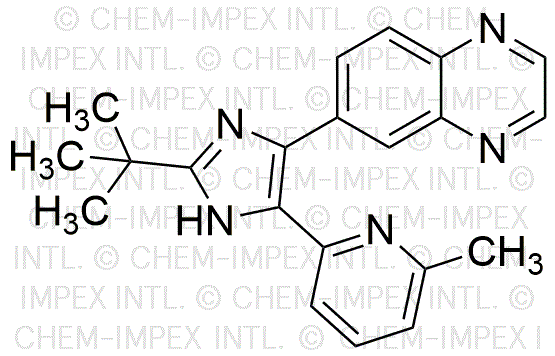SB-525334 is widely utilized in research focused on:
- Oncology Research: This compound is being explored for its potential as an anti-cancer agent, particularly in targeting specific pathways involved in tumor growth and survival.
- Neuroscience Studies: Researchers are investigating its effects on neurodegenerative diseases, aiming to understand how it might protect neuronal cells from damage.
- Pharmacological Development: SB-525334 serves as a valuable tool in drug discovery, helping scientists to develop new therapeutic strategies for various diseases by modifying its structure for enhanced efficacy.
- Biochemical Assays: It is used in assays to study enzyme activity and receptor interactions, providing insights into cellular mechanisms and potential drug targets.
- Combination Therapies: The compound is being evaluated in combination with other drugs to enhance therapeutic outcomes, particularly in resistant cancer types, offering a promising avenue for improving patient care.
General Information
Properties
Safety and Regulations
Applications
SB-525334 is widely utilized in research focused on:
- Oncology Research: This compound is being explored for its potential as an anti-cancer agent, particularly in targeting specific pathways involved in tumor growth and survival.
- Neuroscience Studies: Researchers are investigating its effects on neurodegenerative diseases, aiming to understand how it might protect neuronal cells from damage.
- Pharmacological Development: SB-525334 serves as a valuable tool in drug discovery, helping scientists to develop new therapeutic strategies for various diseases by modifying its structure for enhanced efficacy.
- Biochemical Assays: It is used in assays to study enzyme activity and receptor interactions, providing insights into cellular mechanisms and potential drug targets.
- Combination Therapies: The compound is being evaluated in combination with other drugs to enhance therapeutic outcomes, particularly in resistant cancer types, offering a promising avenue for improving patient care.
Documents
Safety Data Sheets (SDS)
The SDS provides comprehensive safety information on handling, storage, and disposal of the product.
Product Specification (PS)
The PS provides a comprehensive breakdown of the product’s properties, including chemical composition, physical state, purity, and storage requirements. It also details acceptable quality ranges and the product's intended applications.
Certificates of Analysis (COA)
Search for Certificates of Analysis (COA) by entering the products Lot Number. Lot and Batch Numbers can be found on a product’s label following the words ‘Lot’ or ‘Batch’.
*Catalog Number
*Lot Number
Certificates Of Origin (COO)
This COO confirms the country where the product was manufactured, and also details the materials and components used in it and whether it is derived from natural, synthetic, or other specific sources. This certificate may be required for customs, trade, and regulatory compliance.
*Catalog Number
*Lot Number
Safety Data Sheets (SDS)
The SDS provides comprehensive safety information on handling, storage, and disposal of the product.
DownloadProduct Specification (PS)
The PS provides a comprehensive breakdown of the product’s properties, including chemical composition, physical state, purity, and storage requirements. It also details acceptable quality ranges and the product's intended applications.
DownloadCertificates of Analysis (COA)
Search for Certificates of Analysis (COA) by entering the products Lot Number. Lot and Batch Numbers can be found on a product’s label following the words ‘Lot’ or ‘Batch’.
*Catalog Number
*Lot Number
Certificates Of Origin (COO)
This COO confirms the country where the product was manufactured, and also details the materials and components used in it and whether it is derived from natural, synthetic, or other specific sources. This certificate may be required for customs, trade, and regulatory compliance.


